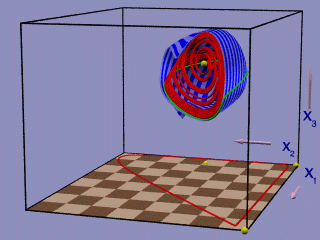Asymptotic behaviour of tri-trophic chains
 If you click on the image, it starts to turn.
If you click on the image, it starts to turn.Martin Boer prepared this three-dimensional state space plot with Povray. The three axes show the prey (x1), predator (x2), and top-predator (x3) population sizes in a chemostat, for a particular choice of throughput rate and concentration of substrate in the feed. Substrate (x0), on which the prey lives, is not shown.
The red worm is the chaotic attractor of the food chain, which is wrapped around the unstable equilibrium (yellow dot). The yellow dots in the plane x3 = 0, represent unstable equilibria of the reduced prey-predator system (without top-predator); the red curve in that plane represents a stable limit cycle. The blue blanket is the separatrix; trajectories that start inside the separatrix converge to the chaotic attractor, the others converge to the limit cycle (of the reduced system). The blanket is cut, to reveal the contents, but in reality it is cut by a plane that is defined through the mass balance. The green curve lying on the separatrix is a limit cycle of the saddle type. All orbits starting on the separatrix are asymptotic to the saddle cycle.
More detailed information:
- Description of the food chain model
- Heteroclinic orbit between a saddle equilibrium and a saddle cycle
- Homoclinic orbit of a saddle cycle
Martin presented a full analysis of tri-trophic chains in his thesis:
Boer, M. P. 2000. The dynamics of tritrophic food chains. Vrije Universiteit, Amsterdam.
Yes, Martin likes to play chess ...